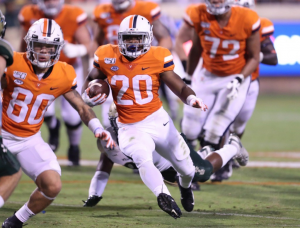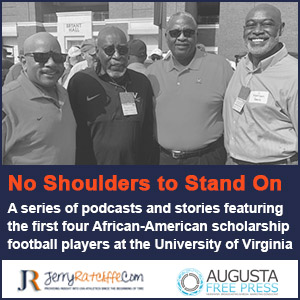Virginia Needs to Find a Way to Get Its Ground Game Going

Virginia first-year running back Mike Hollins’ role is expected to increase, according to head coach Bronco Mendenhall (Photo: UVA Athletics).
By Jerry Ratcliffe
While sitting in the postgame interview room at Notre Dame Stadium a few weeks ago, after Virginia had rushed for a net 4 yards in a loss to the Irish, I asked Bronco Mendenhall if his team could win going forward if it didn’t improve its running game.
The Cavaliers coach said that they couldn’t beat key ACC Coastal Division opponents if the running game didn’t come along.
That was on Sept. 28. We’re more than a month beyond that performance and not much has changed. UVA is ranked No. 123 in the nation (out of 130 FBS teams) in rushing yardage. The Cavaliers are averaging a meager 105.5 yards per game on the ground, dead last in the ACC.
If Virginia remains on that track, it will be the worst average yards rushing per game by a UVA team since 2017 when the average was only 93.5 yards per game, the lowest by a Cavaliers team since 1959.
In fact, three of Virginia’s worst seasons running the football since the end of the Al Groh era in 2009, will have occurred in the last four years in offensive coordinator Robert Anae’s system if the 105.5 average doesn’t rise over the remaining games.
UVA hasn’t had a 100-yard rusher in eight games. The closest a Cavalier back has come was true freshman Mike Hollins’ 78 yards (two TDs) on 11 carries vs. William & Mary. Sophomore Wayne Taulapapa was a close second with 77 yards (two TDs) on 14 attempts in the win over Duke.
It’s no surprise that quarterback Bryce Perkins would be Virginia’s leading rusher on the season if not for 26 sacks that stripped him of 190 yards in losses. Taulapapa has the most net hards (341) and only seven yards in losses. Hollins has only 13 rushes all season and is averaging 6.5 yards per carry.
Which begs the question, is it time to give Hollins more touches now that we’re going down the home stretch?
Mendenhall said after the Notre Dame loss that Hollins’ role would probably be expanded going forward. The only problem was that Hollins was about to break loose on a long run when he was stripped of the football, and hasn’t carried it since.
Mendenhall said even before that fumble that he was somewhat reluctant to use a freshman in that role because it was his experience that putting too much emphasis on a freshman running back could impact that players career going forward.
Still, with the ACC Coastal Division lead up for grabs this Saturday night in Chapel Hill, is it time to throw caution to the wind and give Hollins another shot?
Asked how long does it take for Hollins to earn another opportunity, Mendenhall delivered a long and thoughtful answer.
“We watch every carry every day in practice, so I can’t put a definite timetable on it,” the coach said. “We measure if the ball is on the ground in practice and we simply measure demeanor, confidence, and outcome as well, and then risk.
“And so I pushed hard to give him an opportunity in the game where he went without the ball, and I pushed hard for it for about five weeks. I am the head coach, but that doesn’t mean I’m going to mandate. So sometimes I’m wrong and sometimes I push or want things to happen faster than they’re ready for.”
We’re assuming the push back is coming from either Anae or running backs coach Mark Atuaia.
Mendenhall believes that Hollins is a dynamic ball carrier, which seems exactly what this teams right now, regardless of how inefficient the offensive line may be.
“Mike has such a bright future,” Mendenhall said. “We are measuring the short-term outcome versus long-term development within our program, and those are some hard decisions. All I can tell you is we watch him every day with that in mind.”
One of those UVA linemen, Olusegun Oluwatimi, who blocks for Hollins in practice every day, said this when asked about how good the freshman from Baton Rouge, La., really is.
“He’s a beast,” Oluwatimi said. “Fast, physical, strong.”
None of this is a rap on Taulapapa. He rushed for 52 yards and two TDs in the first half against Louisville but got only three touches the second half when Anae pulled the plug on the running game.
“In relation to the game, yeah, game management,” Mendenhall said. “It just seemed that we became, through personnel and through some of our formations, fairly predictable and need to fix that.”
How did Anae fix that?
“The best way and easiest way to do that was through the throw,” Mendenhall said.
The coach said he loved Taulapapa’s consistency and reliability, in addition to his production.
“Four yards per carry would be my ideal for him, and we’re close to that (4.2 actually),” Mendenhall said. “If you give him teh ball three times in a row, it gives you a first down. So while it might not be the flashiest and most dynamic, we would certainly like to complement that with our quarterback carrying the ball, which I think would enhance both of their production.”
North Carolina is ranked No. 73 in the country in rushing defense, allowing 165 yards per game to opponents. Louisville is ranked No. 84, an improvement after playing Virginia.








